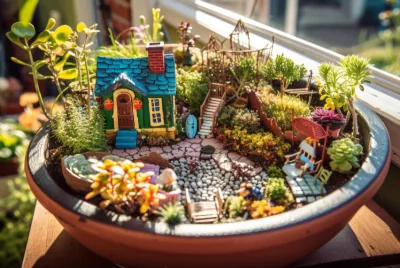From Concrete Jungle to Garden Paradise: Balcony Gardening 101
Are you feeling overwhelmed by the concrete jungle that is your new urban balcony? Don’t worry, because we’ve got the ultimate guide to help you transform your small outdoor space into a lush garden paradise. In this article, we will walk you through everything you need to know about balcony gardening, from planning your layout and choosing the right plants to maximizing space with vertical gardening and creating a relaxing outdoor oasis. By the end, you’ll be equipped with the tools and knowledge to turn your balcony into a green haven that brings you joy and tranquility. So let’s dive in and start your balcony gardening journey today!
Planning a layout for your Balcony Garden
It is important to take some measurements of your balcony to know what kind of space you will be working with. There are some questions to consider before diving into the actual gardening:
- Do you want to leave some area out for some outdoor furniture? It is good to plan your outdoor sitting area so that you can plant your garden around it, making it into a nice cozy corner.
- It is it a rental flat, are there any weight regulations that the balcony can handle? Wet soil carries significant amount of weight and it is important to check if your balcony design can withstand that extra weight on it. If you are sure that the balcony is sturdy, you can opt for larger planter boxes. Else you should opt for lightweight plastic pots for your garden.
- How much sunlight is shining on your balcony and from which direction? These are important information that you need to make good decisions on which plants to plant on the balcony.
With these guiding questions, make a rough sketch of your balcony with the estimated positions of the garden furniture and plants. This way, you have a clear vision for your balcony garden layout and consider the types of plants that will thrive in your urban oasis. By selecting the right plants, you can create a beautiful and functional garden that suits your space and lifestyle.
Choosing the Right Plants for Your Balcony
Before you dive into the (almost) unlimited options of plants to choose from, remember that it is easier to start small with less plants, and scale up as you gain experience. Urban gardening on your balcony should be a relaxing and fulfilling experience and you don’t want to ruin the time because you were too ambitious and had too many plants to care for all at once.
There is no hard rule on what kind of plants to choose for your balcony garden. Of course there are some factors such as sunlight exposure, water requirements, and climate compatibility. However, most importantly, it is based on your preferences and time that you can spare on taking care of your garden. If you are a beginner, then it is better to start with plants that are easy to grow and of low maintenance. For example, tomatoes, carrots, peas and potatoes are easy vegetables to boost your confidence of growing your own food.
There are various articles that recommend growing herbs because they thrive in limited spaces. I personally do not like growing herbs because I do not use them a lot in my Asian cooking. Therefore, grow the plants that you like! Even if you choose to just grow flowers, as long as their vibrant colour make you feel happy every time you step into your balcony garden. Remember to choose plants that will complement each other in terms of size and growth habits to ensure a cohesive and visually appealing arrangement.
If you are still undecided, perhaps this post by Rachel can help you get inspired by what to plant in your garden, taking into account the space, can you preserve the extra yield and more important, what you like to eat!
Maximizing Space with Vertical Gardening
Now that you have selected the perfect plants for your balcony garden, let’s explore how vertical gardening can help you make the most of your space. By utilizing vertical space, you can create a lush and abundant garden even in a limited area. Vertical gardening allows you to grow plants upwards, using trellises, wall-mounted planters, and hanging baskets to maximize your growing area. This technique not only adds visual interest to your balcony but also increases the overall yield of your garden by making use of every available inch. As we delve into the world of vertical gardening, we will discover innovative ways to create a thriving garden oasis in the sky, maximizing both space and beauty.
How to do Vertical Gardening on the Balcony
- According to growth habits of Plants: Plants that naturally grow upwards, such as vine varieties like tomatoes, cucumbers, beans, and peas can easily be incorporated into vertical gardening. Additionally, herbs like basil, thyme, and mint can do well in vertical arrangements.
- Use Vertical Structures: Install trellises, arbors, or fences to support climbing plants. You can also repurpose items like pallets, ladders, or hanging shoe organizers to create vertical planting spaces. There are even specialised structures called Living Towers that ensures maximum harvest using minimal space.
- Stackable Planters: Invest in stackable planters or vertical garden kits designed specifically for small spaces. These systems allow you to grow multiple plants in a compact vertical arrangement.
- Hanging Baskets and Pots: Hang baskets or pots from hooks, rails, or the ceiling to utilize overhead space. This is ideal for trailing plants like strawberries, ferns, or petunias.
- Wall-mounted Planters: Install wall-mounted planters or create your own using containers attached to a sturdy frame. This is a great way to add greenery to walls both indoors and outdoors.
- Hydroponic Systems: Consider using hydroponic vertical gardening systems, which allow plants to grow without soil and can be stacked vertically to save space. These systems are ideal for growing herbs, lettuce, and other leafy greens indoors.
- Espalier Fruit Trees: Train fruit trees to grow flat against a wall or trellis using the espalier technique. This not only saves space but also creates a beautiful and productive garden feature.
- Utilize Tiered Shelving: Arrange plants on tiered shelves or plant stands to create a vertical garden display. This is especially effective for showcasing a variety of plant types while conserving floor space.
Essential Tools and Supplies for Balcony Gardening
When it comes to balcony gardening, having the right tools and supplies is crucial for the well-being of your plants. Some essential tools for gardening include hand trowels, pruning shears, watering cans, and a good quality potting mix will help you maintain and nurture your garden. Additionally, investing in sturdy hardware for hanging baskets and trellises will ensure the stability and support of your vertical garden.
Other than caring for your plants, you have to take care of yourself too! Gardening on the balcony can be exhausting, especially when you are under the sun for a long time. Be sure to invest in some gardening hats and sleeves to keep the sun out of your face, stools and kneepads (your knees with thank you after) that will come in handy when you are repotting your plants for a long stretch of time. With the proper tools and supplies at your disposal, you can effectively care for your plants and create a flourishing garden oasis right outside your door.
Managing Sunlight, Watering and Nutrient Needs
When it comes to balcony gardening, managing sunlight, watering and nutrient needs is essential for the health and growth of your plants. Different plants have varying sunlight requirements, so it’s important to place them in locations that receive the appropriate amount of sunlight each day. Monitor the direction and intensity of the sunlight on your balcony and place plants at the appropriate locations to ensure your plants are getting the right amount of sunlight.
In addition to sunlight, proper watering is crucial for the well-being of your plants. Overwatering can lead to root rot, while underwatering can cause wilting and stunted growth. Make sure to water your plants consistently, taking into account factors such as plant type, weather conditions, and soil moisture levels. Consider using a watering schedule or moisture meter to help you maintain the right balance.
It’s important to provide plants with a balanced nutrient supply to ensure healthy growth and development. Soil testing can help determine nutrient deficiencies and guide fertilizer application. Additionally, if you opt for organic gardening on your balcony, then there are fertilizers and compost that you can easily make at home, that can improve soil structure and provide a slow-release source of nutrients.
By effectively managing sunlight, watering and nutrient needs, you can ensure your balcony garden thrives and flourishes. Next, let’s explore how to deal with pests and diseases to keep your plants healthy and happy.
Dealing with Pests and Diseases
In addition to sunlight and proper watering, it is important to be mindful of pests and diseases that can affect your balcony garden. Keep an eye out for common garden pests such as aphids, spider mites, and caterpillars. Regularly inspect your plants for any signs of damage or infestations, and take action promptly to prevent them from spreading.
One way to naturally deter pests is by planting companion plants that repel insects, such as marigolds, basil, or lavender. Additionally, you can make homemade insecticidal soaps or sprays using household ingredients like dish soap and water. In the case of more severe infestations, consider using organic insecticides as a last resort.
When it comes to diseases, practicing good hygiene, such as cleaning your gardening tools and removing dead or diseased plant matter, can help prevent the spread of infections. Choose disease-resistant plant varieties, provide adequate air circulation, and avoid overwatering to keep your plants healthy.
By taking proactive measures against pests and diseases, you can ensure that your balcony garden remains a thriving and serene outdoor oasis.
Creating a Relaxing Outdoor Oasis with Balcony Gardening
To create a relaxing outdoor oasis on your balcony, consider incorporating elements that promote tranquility and serenity. Integrate comfortable seating options, such as cozy chairs or a hammock, to encourage relaxation and enjoyment of your garden space. Add decorative elements like wind chimes, string lights, or a small water feature to create a soothing atmosphere. Creating a cohesive color scheme with your plant choices and decor can help to enhance the overall aesthetic of your outdoor sanctuary. By curating a peaceful and inviting environment on your balcony, you can easily escape the hustle and bustle of the city and enjoy a tranquil outdoor oasis right at home.
If you have some little helping hands, balcony gardening is also a great way for children to learn how to work with their hands, and of course start learning from a young age about how food is grown. Check out this post where Jennifer provides 10 great choices of vegetables, fruits and herbs that are suitable to plant together with your children and make it a fun Sunday activity!
Conclusion
Transforming your small balcony into a lush garden paradise is within reach with the right planning, plant selection, and space-saving techniques. By incorporating vertical gardening, managing sunlight and watering needs effectively, and being proactive in pest control, you can create a peaceful outdoor retreat right at home.
With a little creativity and dedication, your urban oasis awaits. So, why wait? Start your balcony gardening journey today and unlock the beauty and serenity that a green space can bring to your urban life. As the saying goes, “The best time to plant a tree was 20 years ago. The second best time is now.” So, plant those seeds, nurture your garden, and watch it flourish into a magical sanctuary that will bring you joy for years to come.





